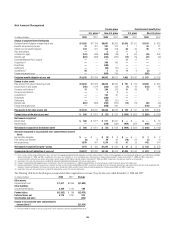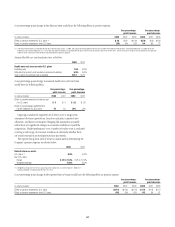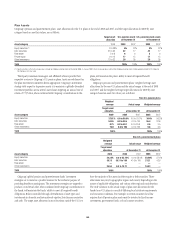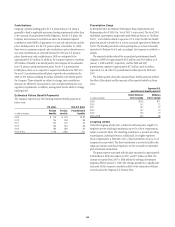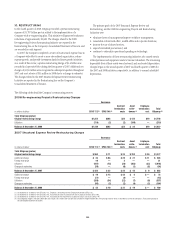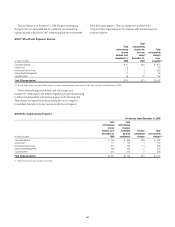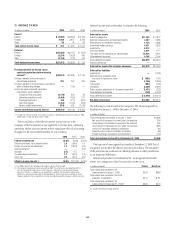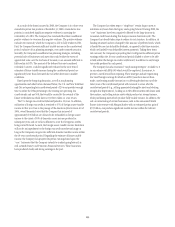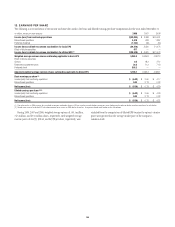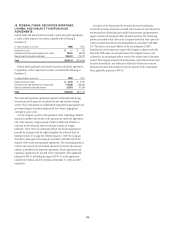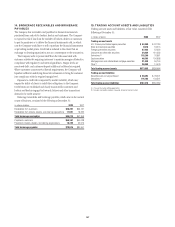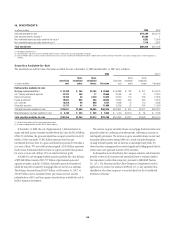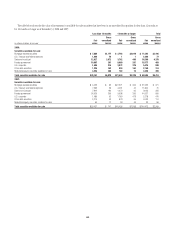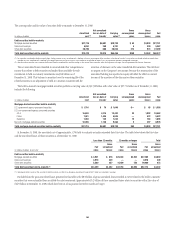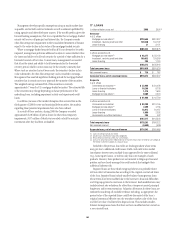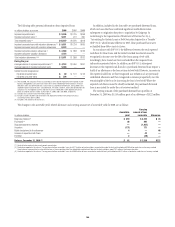Citibank 2008 Annual Report Download - page 160
Download and view the complete annual report
Please find page 160 of the 2008 Citibank annual report below. You can navigate through the pages in the report by either clicking on the pages listed below, or by using the keyword search tool below to find specific information within the annual report.As a result of the losses incurred in 2008, the Company is in a three-year
cumulative pretax loss position at December 31, 2008. A cumulative loss
position is considered significant negative evidence in assessing the
realizability of a DTA. The Company has concluded that there is sufficient
positive evidence to overcome this negative evidence. The positive evidence
includes two means by which the Company is able to fully realize its DTA.
First, the Company forecasts sufficient taxable income in the carryforward
period, exclusive of tax planning strategies, even under stressed scenarios.
Secondly, the Company has sufficient tax planning strategies, including
potential sales of businesses and assets that could realize the excess of
appreciated value over the tax basis of its assets, in an amount sufficient to
fully realize its DTA. The amount of the deferred tax asset considered
realizable, however, could be significantly reduced in the near term if
estimates of future taxable income during the carryforward period are
significantly lower than forecasted due to further decreases in market
conditions.
Based upon the foregoing discussion, as well as tax planning
opportunities and other factors discussed below, the U.S. and New York State
and City net operating loss carryforward period of 20 years provides enough
time to utilize the DTAs pertaining to the existing net operating loss
carryforwards and any NOL that would be created by the reversal of the
future net deductions which have not yet been taken on a tax return.
The U.S. foreign tax-credit carryforward period is 10 years. In addition,
utilization of foreign tax credits is restricted to 35% of foreign source taxable
income in that year. Due to the passage of the American Jobs Creation Act of
2004, overall domestic losses that the Company has incurred of
approximately $35 billion are allowed to be reclassified as foreign source
income to the extent of 50% of domestic source income produced in
subsequent years and are in fact sufficient to cover the foreign tax credits
being carried forward. As such, the foreign source taxable income limitation
will not be an impediment to the foreign tax credit carryforward usage as
long as the Company can generate sufficient domestic taxable income within
the 10-year carryforward period. Regarding the estimate of future taxable
income, the Company has projected its pretax earnings based upon the
“core” businesses that the Company intends to conduct going forward, as
well as Smith Barney and Primerica Financial Services. These businesses
have produced steady and strong earnings in the past.
The Company has taken steps to “ring-fence” certain legacy assets to
minimize any losses from the legacy assets going forward. During 2008, the
“core” businesses have been negatively affected by the large increase in
consumer credit losses during this sharp economic downturn cycle. The
Company has already taken steps to reduce its cost structure. In addition, its
funding structure has been changed by the issuance of preferred stock, which
is funded by non-tax deductible dividends, as opposed to debt type securities,
which are funded by tax deductible interest payments. Taking these items
into account, the Company is projecting that it will generate sufficient pretax
earnings within the 10-year carryforward period alluded to above to be able
to fully utilize the foreign tax credit carryforward, in addition to any foreign
tax credits produced in such period.
The Company has also examined “tax planning strategies” available to it
in accordance with SFAS 109 which would be employed, if necessary, to
prevent a carryforward from expiring. These strategies include repatriating
low taxed foreign earnings for which an APB 23 assertion has not been
made, accelerating taxable income into or deferring deductions out of the
latter years of the carryforward period with reversals to occur after the
carryforward period (e.g., selling appreciated intangible assets and electing
straight-line depreciation), holding on to AFS debt securities with losses until
they mature, and selling certain assets which produce tax exempt income,
while purchasing assets which produce fully taxable income. In addition, the
sale or restructuring of certain businesses, such as the announced Smith
Barney joint venture with Morgan Stanley with an estimated pretax gain of
$9.5 billion, can produce significant taxable income within the relevant
carryforward periods.
154



